Ruddy ShelduckCommon ShelduckEurasian WigeonGadwallEurasian TealMallardNorthern PintailGarganeyNorthern ShovelerMarbled DuckRed-crested PochardCommon PochardFerruginous DuckTufted DuckGreater ScaupCommon Eider Long-tailed Duck Common ScoterVelvet Scoter Common Goldeneye SmewRed-breasted MerganserCommon MerganserRuddy Duck White-headed Duck
Ruddy Shelduck🠉
Tadorna ferruginea

Very slightly larger than the Common Shelduck with a long neck and long legs, as well as long narrow wings. Body orange-brown. Head buffish-white coloured, paler on the face, clearly contrasting with the body. Rump and tail black. Remiges black (secondaries with green gloss) contrasting sharply with the white coverts in flight. Bill black.
Adult male: narrow black collar around the lower neck; chest and mantle dark orange brown.
Adult female: no black neck-collar. Face whiter. Orange-brown areas paler.
Juvenile: like the female apart from a greyish tinge to the white wing panel.
Voice: loud, trumpeting “rrehh-rrehh”. Also nasal “ehh-ehhh”.
L. 58-70 cm ; W. 110-135 cm.
Similar species: Common Shelduck.
©Thomas Galewski
Common Shelduck🠉
Tadorna tadorna
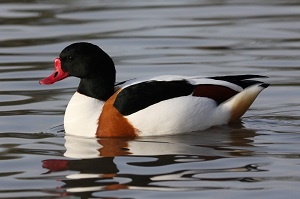
Medium-sized wildfowl with multicoloured plumage. Heavy-bodied. Neck and legs long. Wings long and pointed. Wingbeats fairly deep. Head dark green, bill red. Body white with a broad red-brown pectoral band. Scapulars and primaries black. Speculum greenish. Centre of belly and tip of tail black. Undertail coverts rust-red.
Adult male: bill bright red with a knob on top.
Adult female: bill red, often paler, with a very small knob. Red-brown and black colouring on the chest and belly less clear-cut and more restricted.
Juvenile: forehead, face, chin, throat and underside all white. Crown and hind neck brown-grey. In flight, broad white trailing edge to the wings.
Voice: A whistling or piping “sliss-sliss-sliss” given by the male in spring. Also a “piu-pu”. Females often give a whinnying “gagagaga” in flight.
L. 55-65 cm ; W. 100-120 cm.
Similar species: Ruddy Shelduck.
©Thomas Galewski
Eurasian Wigeon🠉
Anas penelope
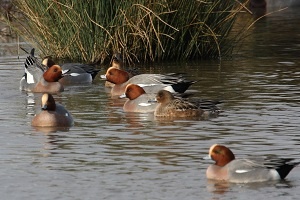
Medium size. Tail short and head rounded with a “high forehead”. Small bill mostly blue-grey with black edges and tip. Pointed tail.
Adult male breeding: unmistakable. Head brown, contrasting with a wide straw-yellow area on the forehead. Chest pinkish. Back and flanks grey. Belly white. Stern black. In flight, large white area on the wing coverts. Speculum greenish with a black border.
Adult female: head and back grey-brown. Chest and flanks more reddish contrasting with the white belly. Speculum dark. Inner secondaries often pale-edged.
Adult male eclipse: very similar to female but generally redder and with a white patch on the upperwing.
Juvenile: like the adult female but the white belly often has vague darker markings and the speculum is a little duller.
Voice: a whistle consisting of two short syllables finishing on a lower note: “vee-oo”.
L. 42-50 cm ; W. 78-87 cm.
Similar species: any in the area.
©Thomas Galewski
Gadwall🠉
Anas strepera
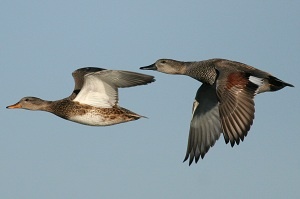
A little smaller than Mallard with drab colouration. Head less rounded. Slimmer, with narrower body and wings. In flight, belly white. Characteristic small white speculum (practically absent in young females).
Breeding male: grey, with dull brown head and black stern. Grey tail. Long scapulars grey-beige. Bill dark grey.
Adult female: the white belly and bill with even-edged orange sides and entirely black culmen, along with the dark grey tail feathers and the white speculum, distinguish the female from Mallard.
Adult male eclipse: Like the female apart from the wings which have the same colouration as in breeding male.
Juvenile: Body with broad gingerish edges to the feathers in contrast with the grey head.
Voice: slurring “ark-ark”, less nasal than in Mallard. Rapid, grating “rekrekrekrek” in flight.
L. 46-56 cm ; W. 78-90 cm.
Similar species: Mallard, Northern Pintail.
©Marc Thibault
Eurasian Teal🠉
Anas crecca
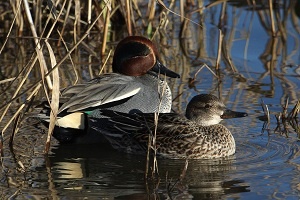
The smallest duck. Fast flight. Wings narrow and pointed. Tail and bill short. Speculum bright green nearest the body, blacker towards the outer edge, bordered with two whitish stripes.
Adult male breeding: head red-brown with a broad green band on the cheek and around the eye, bordered with a thin yellowish stripe. Upperparts and flanks grey with a broad white stripe on the side. Stern yellow edged with black. Bill dark grey.
Adult female: very similar to the female Garganey, speckled with brown. However can be distinguished by smaller size, smaller bill often with orangeish at the base and along the sides; face and throat more uniform, and a narrow white line along the tail. Wing pattern in flight also different.
Adult male eclipse: very similar to the female.
Juvenile: darker above and with the flanks more speckled on a more reddish background.
Voice: whistled, ringing “treek”. Females give a hoarse cackling “ehht-ehht-ehht”.
L. 34-38 cm ; W. 53-59 cm.
Similar species: Garganey.
©Thomas Galewski
Mallard🠉
Anas platynrhynchos
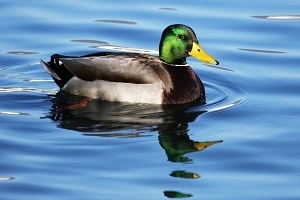
Large sturdy duck. Large bill and large rounded head. Short tail. In flight, wings broad and fairly blunt-tipped. Speculum dark blue with wide white edges. Legs orangeish.
Breeding male: body grey with lilac-brown chest. Head and upper neck green, separated from the brown area on the chest by a white collar. The stern is black with the central tail feathers curled upwards. Bill yellow with a black nail at the tip.
Adult female: browner than the male, speckled with fawn. The face is pale brown with a black line through the eye. The crown is brown. Throat fawn. Bill with black culmen, sides unevenly edged orangeish (orange band often extending across the tip). Sides of tail whitish. Belly pale brown.
Adult male eclipse: like the female but bill dull yellow. Head contrasting more with the reddish-brown chest.
Juvenile: like the female but more reddish above and with clearer, finer streaking below.
Voice: a frequent harsh “quark-quark” and characteristic “quack-quack-quack”.
L. 50-60 cm ; W. 81-95 cm.
Similar species: Gadwall, Northern Pintail.
©Thomas Galewski
Northern Pintail🠉
Anas acuta
Similar size to Mallard but slimmer, more elegant. Neck long and slender. Small rounded head. Tail long and pointed, wings narrow, long and pointed, easily discernible in flight as are the long neck and tail. Legs grey.
Breeding male: distinctive, with the head and nape chocolate-brown, neck white with a white line extending upwards to the rear of the cheeks. Speculum green, edged with rust-brown anteriorly and with white at the rear. Tail black with very long central feathers. Bill slender, black along the centre and at the gape and blue on the sides.
Adult female: slender, with a long neck. Brownish with a uniform pale brown head, chest paler than the finely-marked flanks, and a long pointed tail. Belly pale brown. Bill dark grey.
Adult male eclipse: like the female but retains the breeding colouration of the wings and bill.
Juvenile: like the female but with the body less clearly marked and speculum duller brown.
Voice: trilled “fru-fru-fru”, recalling Eurasian Teal. Also whistling notes.
L. 51-62 cm ; W. 79-87 cm.
Similar species: Mallard, Gadwall.
©Thomas Galewski
Garganey🠉
Anas querquedula
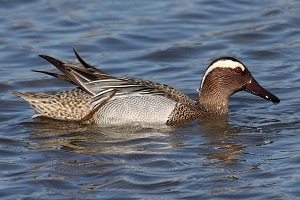
A little larger than the Eurasian Teal. Bill longer and heavier and tail a little longer. Bill grey. Up-ends while feeding much more rarely than Eurasian Teal but dabbles more on the surface of the water.
Adult male breeding plumage: unmistakeable. Broad white semi-circular band extending from the eye to the nape. Rest of the head purple-brown. Chest brown, contrasting with grey flanks. Scapulars pointed, black and white. In flight, the wing is mainly pale grey-blue and the greenish speculum has a broad white edge.
Adult female: Slightly larger than the female Eurasian Teal. Broad pale supercilium contrasting with the dark brown crown and loral line (between the eye and bill). Pale round or oval mark at the base of the bill. Hind neck and cheeks brown, contrasting with the buffish-white throat. In flight, the wings are a little paler especially on the outer part. The wing has a broad white band along the trailing edge.
Adult male eclipse: Like the adult female but with pale grey-blue wings.
Juvenile: like the adult female but belly darker and white trailing edge to wing narrower.
Voice: gives a long dry rattle, varying in pitch. The female also gives a “kneck”.
L. 37-47 cm ; W. 59-67 cm.
Similar species: Eurasian Teal.
©Thomas Galewski
Northern Shoveler🠉
Anas clypeata
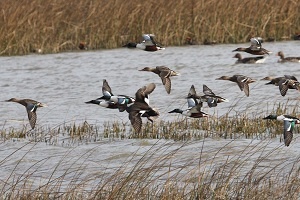
Medium-sized duck with a huge long bill expanded at the tip, and a short neck.
Adult male breeding: distinguished from all other ducks by its green head, white chest, and red-brown belly and flanks. Upper wing coverts pale blue, and speculum green with the front part white. Bill dark grey.
Adult female: very similar to female Mallard but differs in the shape of the bill (which is grey with orange edges) and in the dark underparts contrasting with the white underwing. The upperwing is like that of the male but duller.
Adult male eclipse: like the adult female but with the belly and flanks redder, the head darker and the upper wing coverts more blue.
Juvenile: like the female but darker, with a greyer head.
Voice:
Voix : nasal « took-took » and muffled « gak-gak ».
L. 44-52 cm ; W. 73-82 cm.
Similar species: any in the area.
©Thomas Galewski
Marbled Duck🠉
Marmaronetta angustirostris
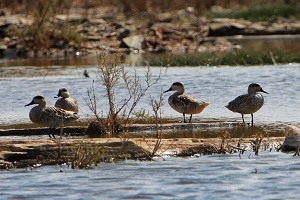
Small duck, slim, with long wings and a long tail. Bill slender, dark grey. There is a crest on the nape, making the head appear big and elongated. Broad brown-black comma-shaped mark around the eye. Whole plumage marbled or speckled with pale brown and darker brown. In flight, wings pale overall, with the outer wing darker and the secondaries paler. The underwing is white with blackish wing edges and primary tips.
The male tends to have a better-developed crest than the female and the juveniles have more diffuse, pale buff markings.
Voice: loud whistling “vii-vih”.
L. 39-42 cm ; W. 63-70 cm.
Similar species: any in the area.
©Thomas Galewski
Red-crested Pochard🠉
Netta rufina
Medium size. Long, sturdy body. Rounded head. Broad white wingbar visible in all plumages.
Adult male breeding: red bill with yellowish tip. Russet-coloured head (bright on the crown). Chest, centre of belly and stern black. Uniform brown upperparts contrasting with the white flanks.
Adult female: much duller than the male. The crown and hind neck are dark brown and contrast with the dirty white sides of the head and the foreneck. Body brown, often with diffuse markings on the flanks. Eye brown. Bill dark grey with a broad flesh-coloured mark near the tip.
Adult male eclipse: similar to the adult female but bill and eyes red.
Juvenile: like the adult female but bill all dark.
Voice: a wheezing “veht” call given by the male. Series of hoarse “vrah-vrah-vrah” calls can also be heard from females.
L. 53-57 cm ; W. 84-90 cm.
Similar species: any in the area.
©Thomas Galewski
Common Pochard🠉
Aythya ferina
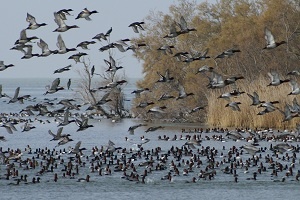
Medium size, a little smaller than a Mallard. Short tail. Long neck. Long bill with concave culmen and peaked crown giving a fairly distinctive profile. Ill-defined grey wingbar present in all plumages.
Adult male breeding: bill black with pale blue-grey distal section. Eye red. Head brown-red and chest black. The back and the flanks are pale ash-grey. The stern is black.
Adult female: brownish-grey on the head and chest, and the back and flanks are greyish. The head pattern is ill-defined, with an indistinct pale loral patch (between the eye and bill), a pale eye-ring, and a pale line behind the eye. In flight, the primaries are buffish with black tips. The eye is red-brown.
Adult male eclipse: similar to male in breeding plumage but normally duller, chest and stern browner.
Juvenile: similar to the adult female but more uniformly brown and with no clear line behind the eye. Eye yellowish olive.
Voice: females give hoarse growls. Males have whistles cut off by a final nasal note, “aaoo-oo-haa”.
L. 42-49 cm ; W. 67-75 cm.
Similar species: Tufted Duck, Ferruginous Duck, Greater Scaup.
©Thomas Galewski
Ferruginous Duck🠉
Aythya nyroca
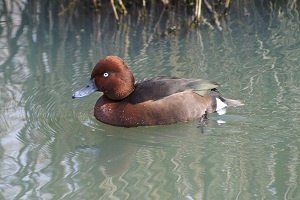
Quite small with a fairly short body but a relatively long neck. The bill is long. The peaked crown and high forehead produce a distinctive silhouette. In flight, broad white wingbar extending to the wingtip. Belly and undertail coverts white.
Adult male breeding: eye white. The entire plumage is deep chestnut-brown (purplish), dull and darker on the back and paler on the flanks. Narrow black neck-collar hard to see. Bill grey, slightly paler at the tip with only the nail black.
Adult female: red-brown with red tint on the head. White on the undertail coverts sharply defined. Eye dark. Distinguished from female Tufted Duck with white on the undertail coverts by the head profile and bill shape.
Adult male eclipse: like adult females but more highly coloured and with white eyes.
Juvenile: like the adult female but duller brown and less pure white on the undertail and belly.
Voice: dry snoring “kerr-kerr-kerr”, and a “vee-view” similar to the call of Tufted Duck given by the males.
L. 38-42 cm ; W. 60-67 cm.
Similar species: Common Pochard, Tufted Duck, Greater Scaup.
©Thomas Galewski
Tufted Duck🠉
Aythya fuligula
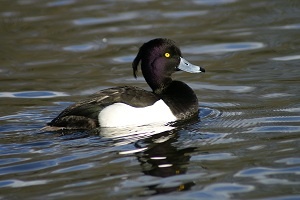
Small, with the body short and compact, a slim neck and a proportionally large head bearing a crest on the nape. Head rounded with a straight forehead and flat crown. Bill short and broad, pale grey-blue with the tip almost all black. Wingbar white and broad.
Adult male breeding: black with violet reflections on the head, contrasting strongly with white flanks and belly. Long drooping crest.
Adult female: brown overall, duller and more uniform above with paler, diffusely-marked flanks. Some white at the base of the bill (some individuals have a lot) but bill shape and colour different from Greater Scaup. Sometimes has white on the undertail coverts. A small crest always present at the back of the head. Eyes deep yellow.
Adult male eclipse: browner and duller than in breeding plumage, with a short crest.
Juvenile: like the adult female but head and chest slightly paler brown, with buffish feathers at the base of the bill and brown eyes.
Voice: harsh calls and hoarse whistling, “vip-vi-viveeveep” descending in pitch and accelerating.
L. 40-47 cm ; W. 65-72 cm.
Similar species: Greater Scaup, Tufted Duck, Ferruginous Duck.
©Thomas Galewski
Greater Scaup🠉
Aythya marila
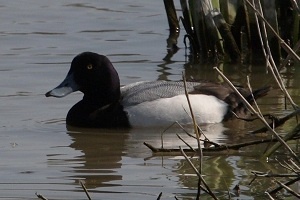
Medium sized duck with a large rounded head. The male is unmistakeable. The female can be similar to some female Tufted Duck but never has a crest, bill is broad, head is larger and very rounded, body is longer and usually only the nail of the bill is black. In flight, broad white wingbar extending a long way across the primaries.
Adult male breeding: Eye yellow. Bill pale blue-grey with black nail. Head black with green gloss. Chest and stern black. Flanks and belly white. Back grey, finely vermiculated with white (visible at close range).
Adult female: body dull brown with paler grey-brown flanks and slightly darker on the back. The back has fine grey patterning visible only at close range. A wide, pure white, rather rounded patch can be seen at the base of the bill, extending broadly onto the forehead. A pale patch appears on the cheeks in spring.
Adult male eclipse: similar to breeding male but head, chest and back brown, and often a little white at the base of the bill.
Juvenile: like the adult female but with less white at the bill base and the body browner, darker above.
Voice: males give a shrill “skop-skop-skop”.
L. 42-51 cm ; W. 71-80 cm.
Similar species: Common Pochard, Tufted Duck, Ferruginous Duck.
©Thomas Galewski
Common Eider🠉
Somateria mollissima
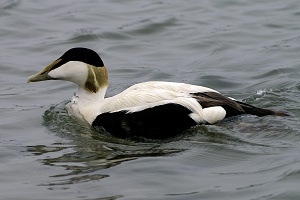
Large heavily-built duck with a short thick neck and a large head with a long sloping bill. Stocky appearance in flight, with broad, relatively short wings. Wingbeats fairly slow and the head held slightly lowered.
Adult male breeding: crown black and nape green. Cheeks white and green. The pinkish chest and white back contrast with the black underparts, flanks and stern. In flight, remiges black and most wing coverts white. Bill greenish with a pale tip.
Adult female: brown with dark barring. Bill grey-green with a pale tip. Axillaries white. Speculum dark, edged white.
Adult male eclipse: very dark with white upper wing coverts and curved tertials. Chest paler.
Juvenile: like the adult female but greyer, with the markings on the flanks less well-defined and the speculum has no white edge.
Voice: resonant moaning of the male, “a-ouh-oh” and cackling of the females, “gak-ak-ak-ak”.
L. 60-70 cm ; W. 95-105 cm.
©Thomas Galewski
Long-tailed Duck 🠉
Clangula hyemalis
_red_opt.jpg)
Small black-and-white duck with a rounded head and a short, thick bill. Wings fairly long and pointed, all black, and white sides to the tail. The male in all plumages has long central rectrices forming a spike. These feathers are often raised when the bird is swimming. The system of moult is complex in Long-tailed Duck and the adults of both sexes have four plumages each year, which makes it quite difficult to determine the age and sex.
Adult male: in winter, it is basically black and white, with the chest as well as a patch on the lower part of the head black and the crown, belly and scapulars white or pale grey. Bill black with a large pale band across the middle. In summer, it is mainly brown-black with whitish flanks and belly.
Adult female: bill grey. In winter, crown and upperparts dark brown. Chest brownish. In summer it is like the male, but duller and does not have the long central rectrices, while it always has a pale collar around the lower neck.
Juvenile: like the winter adult female but with the head generally darker and the scapulars shorter and more rounded.
Voice: resonant, nasal call “geck-aweh”.
L. 39-47 cm ; W. 73-82 cm.
©Aurélien Audevard
Common Scoter🠉
Melanitta nigra
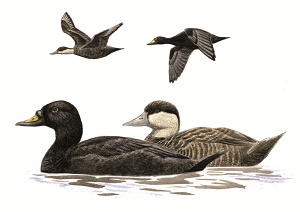
Medium-sized duck, quite stocky with a relatively long tail. The bill is small, with a knob on the base in the male. The neck is fairly slender. Distinguished by its dark plumage and lack of white in the wings. Legs black. Usually dives by making a small leap with the wings held close to the body. Wing-flapping is characteristically followed by a lowering of the head.
Adult male: completely black apart from a yellow patch on the culmen. In flight, the primaries are paler than the rest of the wing.
Adult female: dark grey-brown with paler cheeks, recalling female or juvenile Red-crested Pochard. Belly paler brown than the upperparts. Bill completely blackish.
Juvenile: like the adult female but with the belly whitish and the plumage more uniformly brown.
Voice: sharp, whistled “ehk-ehk-ehk”.
L. 44-54 cm ; W. 70-84 cm.
Similar species: Velvet Scoter, female Red-crested Pochard.
Velvet Scoter🠉
Melanitta fusca
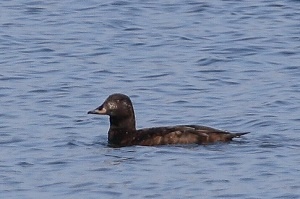
Medium to large-sized. Heavily-built with an elongated body. Bill quite big and conical. The lower part of the neck is thicker. Webs of feet red. Wings fairly broad, with white secondaries easily visible at long range. White in the wing visible in birds settled on the water. Dives without leaping out of the water, with the wings held close to the body. Flaps the wings with the head raised.
Adult male: all black apart from the white secondaries, and a white semicircular mark below the eye (difficult to see). Bill mainly orange-red with black on the sides and underneath.
Adult female: brown with white secondaries. The head pattern is variable and in summer females have a fairly well-defined pale patch on the cheeks and usually also a large pale patch on the lores.
Juvenile: like the adult female but belly paler and head markings more distinct.
Voice: hissing “aah-er” given by the male and little hoarse grunting calls by the female.
L. 51-58 cm ; W. 79-97 cm.
Similar species: Common Scoter.
©Frédéric Pelsy
Common Goldeneye 🠉
Bucephala clangula
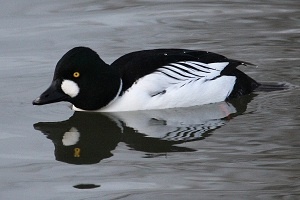
Compact, medium-sized. Large peaked head and short neck. Bill relatively small and triangular. Black primaries contrasting with the mainly white inner wing in adults. Flight rapid.
Adult male breeding: eye yellow. Head blackish with green gloss. Chest, belly and flanks white. Back and stern black. Scapulars white with fine black streaking. Bill dark.
Adult male eclipse: very similar to adult female (see below) but with much white in the forewing. Some males have a whitish crescent-shaped mark on the lores.
Adult female: head brown and eye yellow. Collar and belly white. Chest and flanks ash-grey. Upperparts slightly less dark. In breeding plumage the bill has a yellow band across it, while during the rest of the year it is dark grey.
Juvenile: like the female but has no collar and the plumage is more grey-brown overall.
Voice: loud, harsh, growling “krehhh”.
L. 40-48 cm ; W. 62-77 cm.
©Thomas Galewski
Smew🠉
Mergus albellus
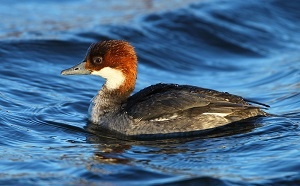
The smallest sawbill, fairly stocky with a relatively short, grey bill. The wing has a large white area on the coverts and the secondaries are dark, bordered with white in front and at the rear.
Adult male breeding: white with black markings. Head white with a black patch on the lores and around the eye. Black line on the back of the head. Back black. Scapulars white.
Adult male eclipse: like the adult female but lores distinctly blacker and back darker.
Adult female: grey-brown with dark red-brown head contrasting with the white throat and part of the cheeks. Lores darker.
Juvenile: like the adult female but belly slightly dirtier white and lores browner.
Voice: the male has a deep, accelerating, croaking call which is very rarely heard. The female has a hoarse “krrr”.
L. 38-44 cm ; W. 59-69 cm.
©Aurélien Audevard
Red-breasted Merganser🠉
Mergus serrator
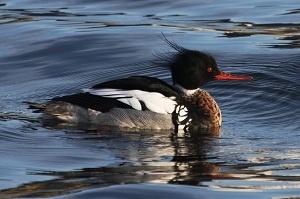
Medium-sized and slenderer than Common Merganser. Bill slimmer at the base and more hooked at the tip. Crest wispier and usually shorter, giving a smaller-headed impression. Neck more slender.
Adult male breeding: head black with green gloss. Collar white. Chest fawn-coloured streaked dark. Back black. Fore-flanks black with white spots. Remainder of flanks grey. Much white in the wing in flight but less extensive than in Common Merganser.
Male in eclipse: like the female but with a large white wing patch.
Adult female: similar to the female Common Merganser but chin and neck not clearly demarcated. Crest shorter. Head paler brown. Loral line usually dark. Eye red. Back and flanks browner. White rectangle in the inner part of the wing divided by a black line.
Juvenile: like the adult female but bill duller and crest shorter.
Voice: harsh grunting by the female and a subdued disyllabic call by the male.
L. 52-58 cm ; W. 69-82 cm.
Similar species: Common Merganser.
©Thomas Galewski
Common Merganser🠉
Mergus merganser
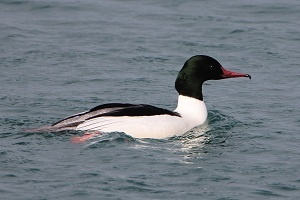
Large, with a slender body. Long red bill, deep at the base, narrow along its length and hooked at the tip. Bushy crest at the back of the head.
Adult male breeding: white on the neck, chest and underparts with salmon-pink tones in winter. Black above. Head and upper neck black with green gloss. Crest smooth, giving a rounded profile to the head. In flight, outer half of the wings black and inner half mostly white.
Adult male eclipse: like the adult female but with a large white wing patch.
Adult female: head fairly dark red-brown contrasting with the clearly demarcated white on the chin, and similarly shows a clear, sharply defined border between the brown upper neck and the paler lower neck. Crest more untidy than the male’s. Body greyish. In flight, white square on the wing formed by the secondaries and greater coverts.
Juvenile: like the female but bill duller, crest shorter, lores pale with dark edges and iris pale.
Voice: sonorous “errrr” or “kroo-kroo” recalling Red-breasted Merganser.
L. 58-68 cm ; W. 79-94 cm.
Similar species: Red-breasted Merganser.
©Thomas Galewski
Ruddy Duck🠉
Oxyura jamaicensis
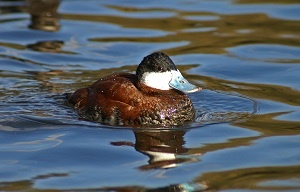
Similar to White-headed Duck but slightly smaller with a concave bill.
Adult male breeding: bill blue. Crown and nape black, contrasting strongly with the white cheeks. Body red-brown. Tail black, undertail white.
Adult male eclipse: like the breeding male but bill grey and body dirty brown.
Adult female and juvenile: like the male but with cream-coloured cheeks crossed by a curved dark stripe, more blurred and less well-defined compared with White-headed Duck.
Voice: usually silent.
L. 35-43 cm ; W. 52-62 cm.
Similar species: White-headed Duck.
©Thomas Galewski
White-headed Duck 🠉
Oxyura leucocephala
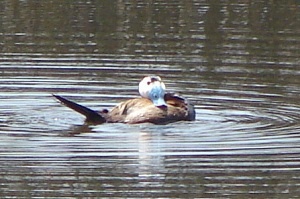
Small diving duck, though a little larger than Ruddy Duck with a slightly larger head. Bill always swollen at the base.
Adult male breeding: bill pale blue. Body light brown. Head mainly white (but some males can be completely black-headed) with a blackish stripe on the crown, nape and neck. Undertail coverts dark.
Adult male eclipse: like the breeding male but bill grey and plumage duller.
Adult female and juvenile: body brown. Dark brown crown extending below the eye. Cheeks whitish with a conspicuous dark stripe. Crown dark brown.
Voice: grunting and whistling calls but usually silent.
L. 43-48 cm ; W. 62-70 cm.
Similar species: Ruddy Duck.
©Sophia Metallaoui




.png)
